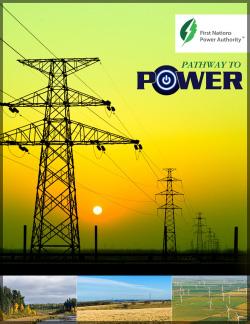Pathway to Power
By Anna Guy
First Nation Power Authority (FNPA) is a breaking new ground for First Nations’-owed power generation companies. The first and only First Nations governed, not-for-profit development company of its kind in North America, FNPA has connected Aboriginal and Corporate Canada in the development of environmentally-preferred power generation projects with the crown utility in Saskatchewan, SaskPower, since 2011.
In May of 2018, FNPA and SaskPower signed a ground-breaking agreement to source 20 megawatts of flare gas power generation projects—worth an estimated $300 million of potential revenue over 20 years. The agreement represents the importance of including First Nations the power future of this province, from an economic and environmental perspective.
Flare gas power generation represents a significant new economic development and opportunity for power projects led by Aboriginal communities and businesses. A source of electricity, Flare gas power generation redirects waste flare gas from oil and gas operations and uses it to produce electricity, resulting in less atmospheric contaminants and more power meet the growing demand for electricity in Saskatchewan.
“We are proud to celebrate this pioneering agreement between our government and the First Nations Power Authority, which will contribute to Saskatchewan’s climate change strategy in a very meaningful way,” said Minister Responsible for SaskPower Dustin Duncan. “By supporting the adoption of innovative emission reduction technologies such as this, we are supporting all sectors of
Saskatchewan’s economy in an effort to reduce their carbon footprint. We are committed to a cleaner electricity sector, and a cleaner oil and gas sector, but in a manner that is financially sustainable and responsible.”
With this Agreement, the FNPA is responsible for securing Aboriginal-led flare gas power production projects then power purchase agreements will then be signed and negotiated for the electricity to be sold to SaskPower and distributed on the provincial power grid over the next 20 years. Currently, FNPA and North-western Saskatchewan Cree reserve Flying Dust First Nation are working on developing a flare gas power generation opportunity.
“Flaring of gas into the atmosphere releases hydrocarbons and emissions into the atmosphere,” says FNPA Chief Executive Officer Guy Lonechild. “In fact, flaring of gas accounts for five times the amounts of emission than other sources of energy. The significance of pioneering this flare-to-power technology in Saskatchewan is that we are helping reduce emissions in what I think is important time when discussion between the Federal and Provincial governments around the carbon tax and carbon capture and sequester is so prevalent. We see multi-nation projects gaining traction in helping to reduce the economic footprint while benefitting economically from these projects.”
Calling the agreement “an important milestone,” Lonechild adds that FNPA was created exactly to produce long-term commitment between SaskPower and Saskatchewan First Nations such as this.
“The process that FNPA has selected (specifically with Flying Dust First Nation and their partner) allows us to provide helpful guidance and criteria to make each project economical,” says Lonechild. “This will provide a template for other First Nations to follow when it comes to getting into the finer nuances of finalizing a power purchase agreement, a project pathway to get into the procurement processes.”
Indeed, FNPA has formed strategic partnerships with other First Nations in the procurement process, for example Bullfrog Powers’ solar power projects in remote First Nations communities across Saskatchewan, including in Fond-du-Lac and Hatchet Lake.
Long-term Outlook
“I want to believe that our long-term relationship going forward with SaskPower will be one that we see enhanced participation from First Nations in the energy sector, and a long-term commitment (beyond our ten-year commitment that expires in 2022),” says Lonechild. “We see the same vision as SaskPower, who are committed to increasing its target for
renewable-energy generation capacity from 25 per cent to 50 per cent by 2030 is striving for 50 per cent renewable energy sources by 2030. We have a real commitment to seeing that through.”
Looking forward is what FNPA does: through prescient leadership, FNPA’s work can contribute to meaning wealth creation for First Nations and environmental stewardship for all. Says Lonechild, “The new vision for FNPA, from vision to implementation, can be applied all over Canada. There are many people waiting to see what can happen when we cooperate and work together and I think Saskatchewan and Alberta are really good markets to do that.”
FNPA sees expansion into Eastern and Northern Ontario as viable options going forward. “We want to become a truly national organization to deliver a lower costing electricity, build green infatuation and wealth creation opportunities for First Nations.”







